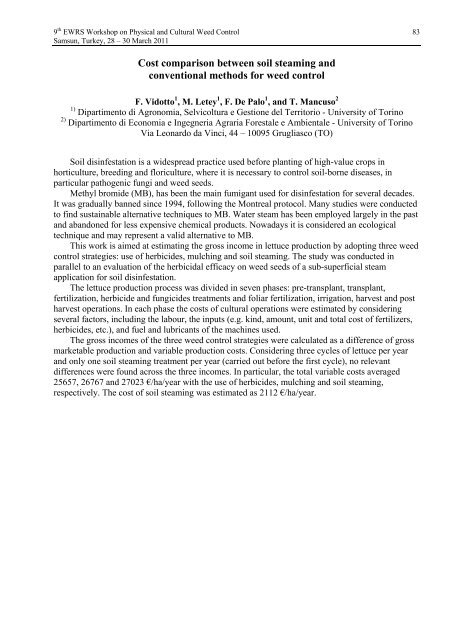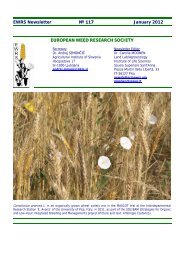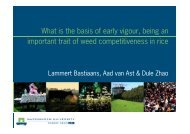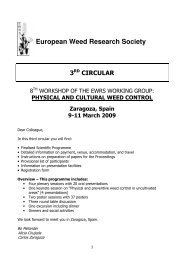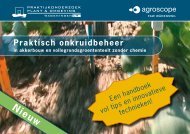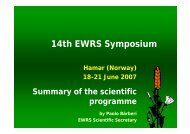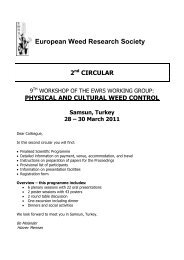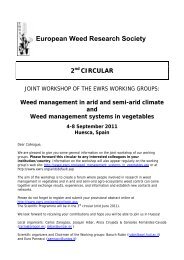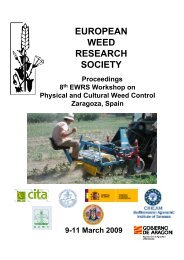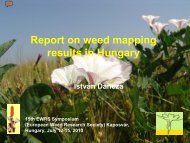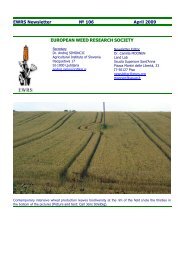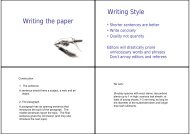Physical and Cultural Weed Control Working Group of - European ...
Physical and Cultural Weed Control Working Group of - European ...
Physical and Cultural Weed Control Working Group of - European ...
Create successful ePaper yourself
Turn your PDF publications into a flip-book with our unique Google optimized e-Paper software.
9 th EWRS Workshop on <strong>Physical</strong> <strong>and</strong> <strong>Cultural</strong> <strong>Weed</strong> <strong>Control</strong> 83<br />
Samsun, Turkey, 28 – 30 March 2011<br />
Cost comparison between soil steaming <strong>and</strong><br />
conventional methods for weed control<br />
F. Vidotto 1 , M. Letey 1 , F. De Palo 1 , <strong>and</strong> T. Mancuso 2<br />
1) Dipartimento di Agronomia, Selvicoltura e Gestione del Territorio - University <strong>of</strong> Torino<br />
2) Dipartimento di Economia e Ingegneria Agraria Forestale e Ambientale - University <strong>of</strong> Torino<br />
Via Leonardo da Vinci, 44 – 10095 Grugliasco (TO)<br />
Soil disinfestation is a widespread practice used before planting <strong>of</strong> high-value crops in<br />
horticulture, breeding <strong>and</strong> floriculture, where it is necessary to control soil-borne diseases, in<br />
particular pathogenic fungi <strong>and</strong> weed seeds.<br />
Methyl bromide (MB), has been the main fumigant used for disinfestation for several decades.<br />
It was gradually banned since 1994, following the Montreal protocol. Many studies were conducted<br />
to find sustainable alternative techniques to MB. Water steam has been employed largely in the past<br />
<strong>and</strong> ab<strong>and</strong>oned for less expensive chemical products. Nowadays it is considered an ecological<br />
technique <strong>and</strong> may represent a valid alternative to MB.<br />
This work is aimed at estimating the gross income in lettuce production by adopting three weed<br />
control strategies: use <strong>of</strong> herbicides, mulching <strong>and</strong> soil steaming. The study was conducted in<br />
parallel to an evaluation <strong>of</strong> the herbicidal efficacy on weed seeds <strong>of</strong> a sub-superficial steam<br />
application for soil disinfestation.<br />
The lettuce production process was divided in seven phases: pre-transplant, transplant,<br />
fertilization, herbicide <strong>and</strong> fungicides treatments <strong>and</strong> foliar fertilization, irrigation, harvest <strong>and</strong> post<br />
harvest operations. In each phase the costs <strong>of</strong> cultural operations were estimated by considering<br />
several factors, including the labour, the inputs (e.g. kind, amount, unit <strong>and</strong> total cost <strong>of</strong> fertilizers,<br />
herbicides, etc.), <strong>and</strong> fuel <strong>and</strong> lubricants <strong>of</strong> the machines used.<br />
The gross incomes <strong>of</strong> the three weed control strategies were calculated as a difference <strong>of</strong> gross<br />
marketable production <strong>and</strong> variable production costs. Considering three cycles <strong>of</strong> lettuce per year<br />
<strong>and</strong> only one soil steaming treatment per year (carried out before the first cycle), no relevant<br />
differences were found across the three incomes. In particular, the total variable costs averaged<br />
25657, 26767 <strong>and</strong> 27023 €/ha/year with the use <strong>of</strong> herbicides, mulching <strong>and</strong> soil steaming,<br />
respectively. The cost <strong>of</strong> soil steaming was estimated as 2112 €/ha/year.


